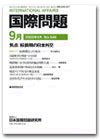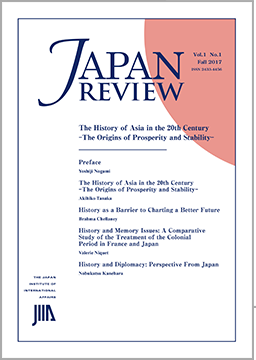Column/Report
|Top page|Print/Mobile page|Tweet
JIIA Strategic Comments(No.11):
An Update of Licensing Policies and Procedures on Export Controls for South Korea (ROK)
Yoshiaki Takayama (Research Fellow, Center for Disarmament, Science and Technology, JIIA)
The Ministry of Economy, Trade and Industry (METI) of Japan announced on July 1 2019 that it would update the licensing policies and procedures on export controls for the ROK. There are two changes in this update: (1) exporters must now apply for individual export licenses to export the materials specified in the export control; (2) METI would revise the export control category of the ROK. This commentary analyzes the contents of these changes and discusses its implications.
Not protectionism
Updating export controls for the ROK by the Japanese government is not a protectionist measure contrary to the principle of liberalism, as the media has reported. In announcing this action, METI stated that “while export control systems are structured based on international trust, as the result of consideration by the Ministries concerned, it was judged the trust between Japan and the ROK was severely undermined”, and that “cases of inadequate management on the ROK related export control came to surface”.
Export controls underpin the free trade system by governing the export and transfer of sensitive goods and technologies related to Weapons of Mass Destruction (WMD) and conventional weapons in accordance with international norms, under which each country has its own export control system. It is not right to argue that Japan is against the principle of free trade by revising its licensing policies and procedures on export controls based on security concerns. Although we can’t say definitively because the Japanese government has not disclosed the details of the “inadequate management”, due to the limitations in the domestic export control system in the ROK and the absence of export control consultations between Japan and the ROK, Japan is looking to reduce the risk of the transfer of these sensitive materials, and the serious security concerns which would accompany this, by updating the licensing policies and procedures of export controls for the ROK.
Details of the measures
In order to understand the above points, we will look at the concrete contents of the measures taken by the Japanese government.
First, applying for individual export licenses for the export of three listed items: polyimide fluoride, resists, and hydrogen fluoride (and the transfer of manufacturing technology related thereto). This measure was implemented 3 days after METI’s announcement on July 4, and the bulk licenses for those three items are no longer applicable. Fluorinated polyimides are used in organic EL displays, such as smartphone displays; resist materials are applied to semiconductor substrates; and hydrogen fluoride is used to clean silicon or as an edging gas in the semiconductor manufacturing process. All are high-end commercial products. However, because they are also available for military use, they are subject to list regulations under the multilateral export control regime. Polyimide fluoride, which is widely used in the aerospace and electronics fields, is listed as special materials in the Dual-use List of the Wassenaar Arrangement (WA). Resist materials are listed as electronics in the WA Dual-use List. Hydrogen fluoride is a precursor of nerve agents and is used in the production of sarin. It is therefore listed on the regulation list of the Australia Group (AG). In the past, it was discovered that Germany had exported hydrogen fluoride to Syria, which produced a global response.
Since the relevant general bulk export license for these three items are no longer applicable, exporters must apply for an individual export license in order to export these items to the ROK. According to some reports, it takes about 90 days to complete the review. However, it is estimated that only 40 to 50 days is necessary for the actual review period for exports which have no security concerns. 90 days is the maximum length of time for the license review process. It can be exported once it passes the inspection process. If the licensing authority determines that the exported goods and technologies are not diverted for military use, or are not re-exported or re-transferred to third countries without permission, the export license is granted to the relevant case. The need to obtain export licenses for each individual contract does not necessarily mean that export applications will be rejected. Only for projects deemed inappropriate in terms of the risk of military use or unauthorized re-exports or re-transfers, are rejected. Above all, in terms of reducing the risk of the latter, an important reference point in reviewing individual export applications is whether export control in the recipient country (the ROK) is adequate.
Secondly, revising their export control category refers to the removal of the ROK from the “White Country” category. Under Japan’s export control system, the country that has joined treaties on WMD such as Nuclear Non-Proliferation Treaty (NPT), has joined all multilateral export control regimes such as the Nuclear Suppliers Group (NSG) and WA, and has introduced the catch-all regulation systems is categorized as “white country.” At present, 27 countries, such as the United States and the United Kingdom, are categorized as “white country.” Because it is considered that there is no risk of WMD proliferation from these countries, these countries have been granted preferential treatment for export control, such as exemption from catch-all regulations, under the Japanese export control system. The ROK became a white country in 2004, and it has been the only white country in Asia. The METI announced on July 1 that it would welcome public comments on the revision of the order to remove the ROK from the white countries (public comments will be accepted until July 24). According to some reports, the ROK will be excluded from the white country category in August.
After the removal of the ROK from the white country category, exports from Japan to the ROK will be subject to catch-all regulations. The catch-all regulation is a system that requires export approval for unlisted goods (other than goods and technologies that require approval at the time of export), when an exporter (1) is aware that these goods or technologies will be used for the development, manufacture, use or storage of WMD or conventional weapons, or (2) is informed by the METI that an application for approval should be submitted. The purpose of the catch-all regulation systems is to require export licenses for exports that contribute to the development of WMD or conventional weapons, even if they are unlisted goods. In other words, if it is determined that the transaction of certain non-listed goods does not lead to diversion risks, the exporter may export. In terms of reducing the risk of circumventing exports, an important reference point in reviewing export applications is whether recipient countries have an adequate level of export control systems, including catch-all regulation systems.
As we have seen, the update of export control licensing policies and procedures is not the introduction of embargo measures against the ROK. With no risks of military use or circumventing exports, it is possible to export the three items to the ROK subject to individual review. Even if the ROK is excluded from the white list, it is still possible to export non-listed goods to the ROK if it is determined that there is no risk of military use or circumventing exports. Therefore, it would be also incorrect to argue that the Japanese measures are against WA which requires that export controls should not impede “bona fide civil transactions,” because only exports which do not fall under “bona fide civil transaction” are banned. The purpose of the update by the Japanese government is against the risk of diversion which would have security implications, and the impacts of the update will be limited on civil transactions.
Conclusion
By updating its licensing policies and procedures on export control, the Japanese government expects that the ROK export control system and its implementation will meet international standards. The international standardization of export control, of course, also contributes to the foundation of free and sound trade in the high-tech sector by leveling the playing field.
The Japanese government’s latest measures are neither aimed at turning a blind eye to the free trade system nor at protectionist measures. Rather, it would be thought that Japan, through mitigating security risks associated with high-tech trade by advancing the leveling of export control, seeks to strengthen the foundation of the free trade system.
(July 12, 2019)
(2019-07-17)
Topics
Membership
 Archive of high-quality scholary works translated from Japanese to English
Archive of high-quality scholary works translated from Japanese to English
A highlight of JIIA's recent activities and a summary of its organization.
Publication
Journal

Kokusai Mondai (International Affairs)
No.680 April 2019 "Protecting Human Rights via International Procedures"
Vol.2 No.4 Spring 2019
"Japan and the Post-World War II Liberal International Order"
Books
 What Do Alliances Mean to the US?
What Do Alliances Mean to the US?
(Fumiaki Kubo ed., 2013)






